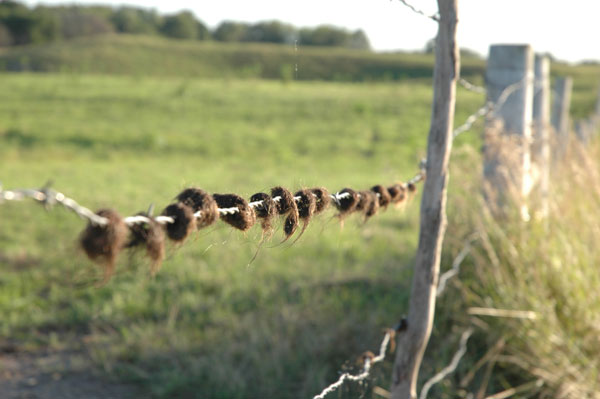7 common cattle fencing mistakes
How to avoid the most common errors in livestock fencing.
December 21, 2022

The corner posts are the key to a strong fence. At least that's what's Jim Gerrish, of American GrazingLands Services LLC, in May, Idaho, and Kevin Derynck, Gallagher territory manager based in Keystone, S.D., have to say about the top mistake when it comes to fencing. Here is their take on the seven most common cattle fencing mistakes.
1. Corner posts are undersized, or not deep enough
This ranks as the top mistake in fencing, be it barbed, high-tensile wire or woven wire. The main issues are undersized posts and corner posts not set deeply enough, particularly in sandy or soft soils. Gerrish, who has clients in 43 states, says, “the depth in the ground should be equal to, or greater than, the height of the top wire.”
Post diameter depends on the strength of the fence. Gerrish says the lightest-duty fence, such as a 1- or 2-wire, high-tensile pasture subdivision fence, only requires a 4- to 5-inch-diameter post. A 5-strand barbed wire fence, or 5- or 6-strand high-tensile wire fence, requires a 6- to 7-inch-diameter post. For net wire fences, Gerrish recommends an 8-inch-diameter post.
How to fix it: Keeping corner posts in the ground is Derynck’s chief concern. He says a 10-foot brace is the ultimate, and he favors a “floating diagonal” bracing system, in which the angle brace is a 4-inch by 10-foot post notched a half-inch into the main corner post. The other end is set on top of the ground opposite the corner post.
And he cautions against using drill stem – the metal pipe byproduct of oil wells – for corner bracing an electric fence. Unlike wood, it can conduct electricity and lessen the efficiency of the fence.
2. Post spacing is too close
Fencers tend to use too many posts, which likely stems from people's experience with barbed wire, where the rule of thumb was 1 post every rod length (16.5 feet).
How to fix it: In an electric-fencing system, Derynck reccomends fence post spacing 80-100 feet apart, or about 50 posts per mile. He suggests using a “stay” – a shorter post that sits on top of the ground and holds wires up – if posts are spaced 100 ft. apart. Gerrish prefers his fence post spacing closer together, at 50-70 feet.
3. Using the wrong sized energizer
Gerrish recommends 1 joule of output per mile of fence, regardless of how many strands of wire. If there’s a total of six miles of fence, it requires a minimum of a 6-joule energizer.
How to fix it: Derynck, who represents Gallagher in Nebraska and the Dakotas, recommends a low-impedance energizer, with a low-amp fuse. “The larger the energizer, the smaller the voltage,” he says, because larger energizers are apt to power through more vegetation and short out. He considers 7,000-8,000 volts high for an energizer.
4. Ground rod is too close together
Grounding is 99% of the electric fence, the specialists explain. Gerrish uses this rule of thumb: 3 feet of ground rods per joule of energizer output. So if the fence is using a 6-joule energizer, 18 feet of ground rods are called for. “Typically this would be three, 6-foot ground rods, spaced at least 10 feet apart,” Gerrish explains.
How to fix it: Gerrish says spacing is key, as a ground rod is essentially an antenna receiving electrons flowing through the soil and back to the energizer, completing the circuit. Ground rods can also interact with a given volume of soil. If three ground rods are driven into the ground 6 inches apart, in essence, they act as one ground rod because of the volume of soil they interact with.
Derynck says most people insert three ground rods near the energizer. He encourages people to space ground rods throughout the whole network of fencing, particularly if the average rainfall of the fenced area is less than ideal for proper grounding.
Galvanized rod is the best for ground rod, and most livestock fencing companies use an insulated galvanized lead-out wire on energizers. “Galvanized isn’t as expensive as copper and you don’t ever have to worry about corrosion,” Derynck says. If there's galvanized wire in the electric fence system, keep everything galvanized. Derynck strictly recommends 12.5-gauge galvanized wire, galvanized ground rods and galvanized connections.
“The most effective place for the ground system is in continuously damp, high-mineral soil,” he adds.
5. Don't moose-proof; make fence wildlife friendly
How to fix it: Rather than strive for a fence that’s elk and moose-proof, Gerrish suggests a flexible fence. When he moved to Idaho from Missouri, the fencing was high-tensile electric on T-posts, but the T-posts were being bent and insulators broken off due to wildlife. He replaced T-posts with PowerFlex fence posts and has had few problems since, he says.
Another consideration is building a low-profile fence. On Gerrish's 2-wire range fences, the top wire is at 30 inches and the second wire is at 20 inches. It’s designed to allow antelope to go under the wires at a dead run, but low enough that elk will hit the fence with their legs and not the heaviest part of their body.
6. Making gate openings carry current
In an electric-fencing system, creating a gate system that conducts current is a challenge.
How to fix it: Derynck recommends placing a floating diagonal brace on either side of the gate opening.
To keep the fence “hot,” trench both insulated hot and cold galvanized wires 1- foot deep under the opening (perhaps deeper in high-traffic areas or low-lying wet spots, or shallower in less-used pasture settings). “The gate no longer needs to carry current, because you have your current going underneath the ground,” he says.
7. Relying on steel posts
“Putting a steel post anywhere into an electric fence is a big mistake, because you are then relying on the insulator to keep your cattle fence from shorting out,” Gerrish says.
How to fix it: Gerrish prefers highly flexible plastic or wood-plastic composite posts, “No matter how good an insulator you get, eventually something's going to break or pop off, and you have the potential for dead-shorting.”
So in a nutshell, it breaks down to these seven tips if you want a reliable electric fence -- and that's everyone's goal, right?
Corner posts are the correct placement and size.
Fence posts need to spaced 50-100 feet apart.
Using the right energizer. They suggest 1 joule of output per mile of fence.
Space your ground rounds far enough apart.
Make cattle fence flexible to be wildlife friendly.
Creating a gate system that conducts current is a challenge, instead trench the fence underground.
Don't use steel posts, instead use flexible plastic or composite posts to prevent shorts.
You May Also Like



